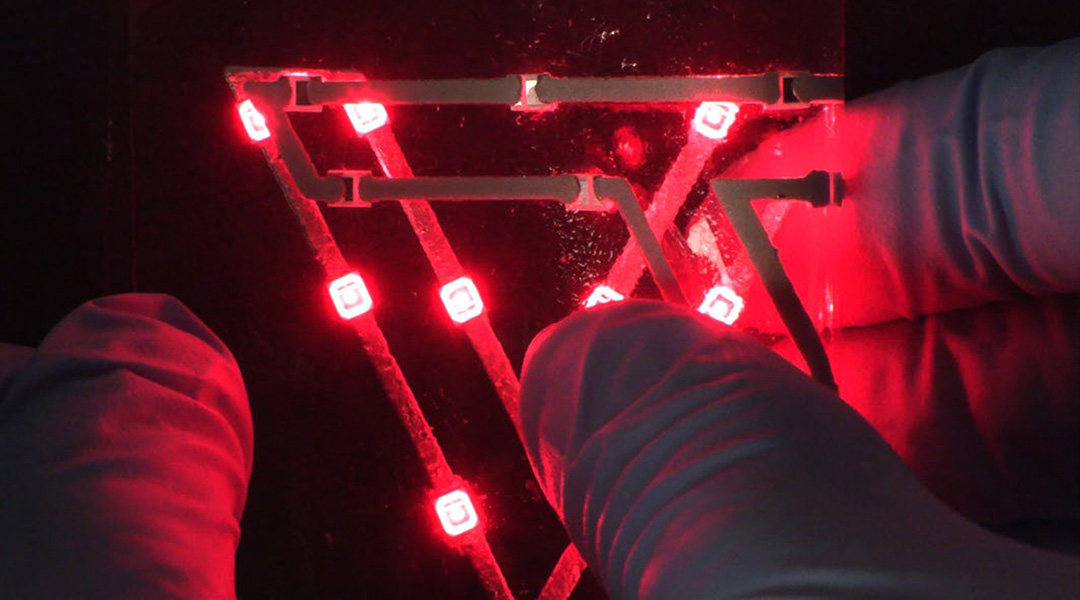Scientists have recently synthesized a composite material whose properties make it an ideal candidate for the burgeoning field of flexible electronics.
“We discovered a liquid metal-based composite that is highly electrically conductive and strongly adhesive,” said Michael Bartlett, associate professor of mechanical engineering at Virginia Tech, in an email. “This enables robust mechanical and electrical connections between soft circuitry and rigid electrical components.”
This includes computer and mobile phone displays, wearable health-monitoring tools, various car, airplane, and environmental sensors, strain gauges on roads and bridges, and many others.
“[Our liquid metal composite] overcomes several challenges in next generation flexible and soft electronics and allows us to create flexible hybrid electronics, which combine the desirable properties of soft electronics and state-of-the-art rigid electronics into a single system,” added Bartlett.
To join various electronic components, scientists and engineers have commonly used hot solders — fusible alloys of metals such as tin, lead, bismuth and indium — but they pose challenges in flexible electronics.
“Traditional solders are rigid and brittle,” explained Wuzhou Zu, a Ph.D. student at Virginia Tech, who worked on the study. “This causes the solder to crack and delaminate when used with flexible and soft substrates as they are bent or stretched, which results in failure. Solder also requires high processing temperatures.”
In addition to solders, polymer-based, electrically conductive adhesives can be used as interconnects in flexible devices, but they also have disadvantages. For example, their conductivity is relatively low and adhesive strength is generally poor.
To overcome these problems, the team developed a material of a different type, which was recently reported in the journal Advanced Functional Materials. “The material we studied is a composite of liquid metal microdroplets of eutectic gallium-indium (EGaIn), silver microflakes, and a flexible epoxy matrix,” said Brittan Wilcox, a Ph.D. student at Virginia Tech and another of the study’s authors.
“We call it E-CASE (electrically conductive adhesive with silver and EGaIn),” he continued. “Our adhesive can be processed at low-temperatures through methods such as stencil printing and 3D printing and can be used with flexible circuit materials that traditional high-temperature solder cannot.
The team’s experimental study showcased not only E-CASE’s impressive adhesive strength and conductivity, but its remarkable mechanical properties. A strip of this material adorned with multiple LEDs could withstand a tight bending radius of about 1 mm without LED failure, and even supported the weight of a car driving over it.
“We hope that this material can play a role in several areas in electronics, robotics, and sensors,” stated Barlett. “As the use of flexible and hybrid circuits grows in fields such as wearable electronics, biomonitoring, soft robots and more, creating robust electrical and adhesive connections at soft-rigid interfaces will be key.”
Despite its success in laboratory experiments, the material’s journey to widespread industrial use could still face challenges. “The material has been demonstrated to work in hybrid electronic systems, but for scalability in manufacturing, we will need to optimize several processing parameters and develop a better understanding of how the materials perform over time,” said Tyler Pozarycki, a Master’s student who also worked on the project.
The team acknowledges the hurdles and anticipates addressing them in the near future, stating they hope that their study will not remain just a scientific experiment, but will lead to a technological leap in many vital industries.
“It would be important to refine the manufacturing process to achieve consistency in microfabrication,” concluded Zu. “This can be particularly challenging at large scales, and a deeper understanding of the process parameters, integration techniques, and characterization approaches will be important.”
Reference: Michael D. Bartlett, et al., A Flexible and Electrically Conductive Liquid Metal Adhesive for Hybrid Electronic Integration, Advanced Functional Materials (2024). DOI: 10.1002/adfm.202313567.
Feature image credit: Michael Bartlett et al.

















